EARTHQUAKE
This week: Earthquake; Island shakes, rattles and rolls; Building work continues; Monday, Monday; Orchard fall; Keeping one step ahead; Spring has arrived early;

Thanks for all the comments on last week’s blog.
I will take some aerial video a little later in the year when the blossom is out. In a month the Almond trees will be covered in pink and white.
My plums trees should have a lot of blossom too and the first green shoots will be on the other trees in the drupe orchard. At the moment things look just a little drab from the air.
I have cut my last logs for this winter. Next week I will remove the central heating pipes between the buildings. This will allow the concrete workshop ceiling to be poured and that will be it for fires until next winter.

I have enough cut now to last, with what ever remaining going back in the woodshed for the next season.

There was also a comment last week about the relative strength of the foundations that have gone into my building. It is because new buildings have to be capable of withstanding a Richter Scale 7 earthquake.

Now this backwater of the Mediterranean is hardly the Pacific Ring of Fire, of which I have some personal experience. But none the less, I have experienced several mild earthquakes in my time here. They were all sufficient to be felt, but did no damage.
This week there has been a storm of micro earthquakes along the edge of the tectonic plate which my home sits on.
The island of Hvar sits on the very edge of the Adriatic micro tectonic plate. This small part of the earth’s crust is far more active to the west in Italy, than here in the east. Here think Mount Vesuvius.
The main local fault line runs between the island and the mainland with a second intersecting with it. But it is the mainland which has suffered in the recent and not so recent past.

A little to the south lies the ancient and much visited City of Dubrovnik. Known in the past as the Republic of Ragusa, it was an independent State from the 14th century. That was until the disastrous earthquake of 6th April, 1667, which killed thousands, including the ruler and laid waste to the city.
The devastation caused the eventual downfall of the city state. The old city that visitors see today is the rebuilt version, because little except the Ruler’s Palace was left standing.
This is believed to be the most powerful earthquake ever to have taken place in what is now Croatia.
Closer to me is the town of Makarska. It is visible on the coast below Svete Jure and the Dinaric Alps, when you are up at St. Michael’s Church in Dol.
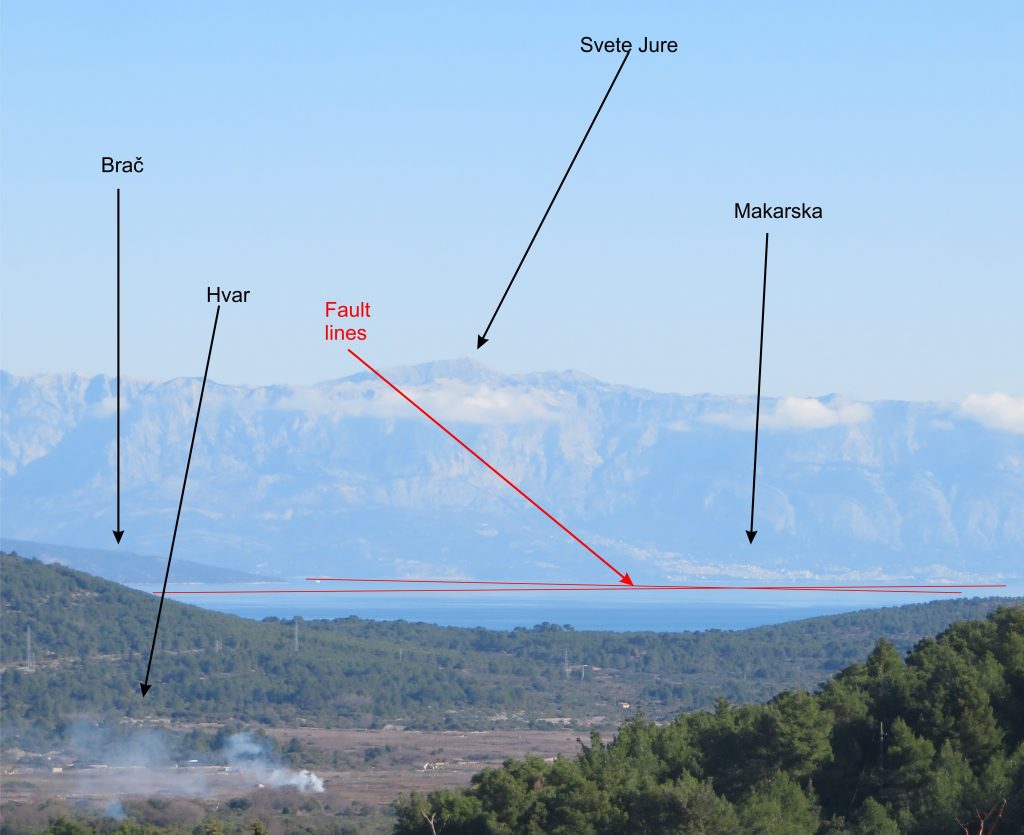
Fifty eight years ago, at 11:03 on January 7th, 1962 a 5.9 magnitude earthquake struck the town. This was followed by a second, more powerful quake.
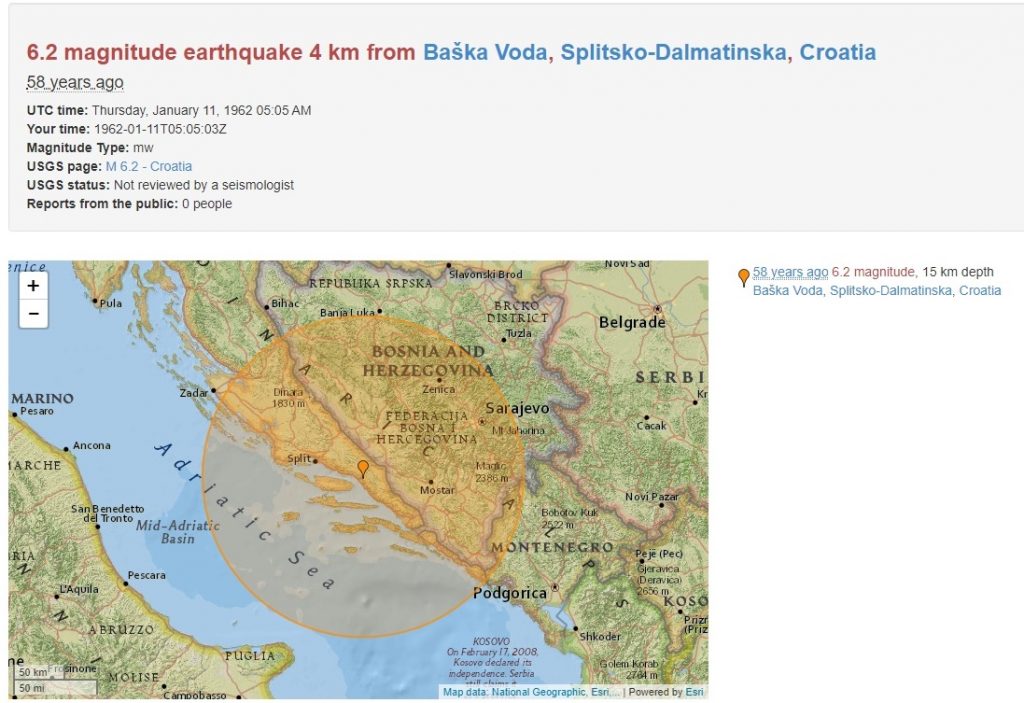
On Hvar itself, the seismic station was set up following a series of earthquakes under the channel between Hvar and Brač.
The largest quake, on 11th January 1962 registered 6.2 on the Richter scale, following a 5.9 four days before.
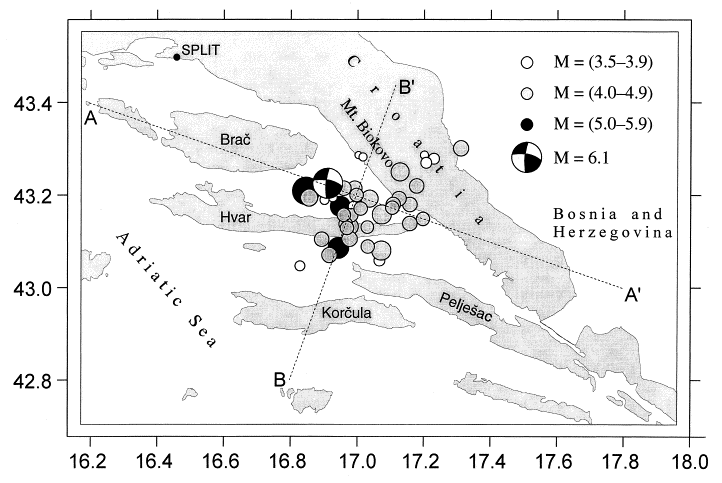
The shocks were felt strongly on the mainland. The event is generally referred to as the Makarska-Hvar or Biokovo earthquake sequence.
The series was important. It was the first properly recorded and analysed large seismic event in the region. The analysis providing a better understanding of the local faults and movements.
The analysis of the Makarska-Hvar earthquakes showed two fault lines crossing at right angles to each other. This intersection was the epicentre of the large earthquake.
Island shakes, rattles and rolls
In 1937, there was a series of earthquakes closer to Stari Grad on Hvar. This swarm of earthquakes were felt by people on the islands of Vis and Brač, and as far north as Split.
Reports from the time describe sharp vertical shocks, accompanied by a deep rumble.
Masonry was cracked in houses and churches throughout Stari Grad, Jelsa, Vrbanj, Svirče, Pitve and Vrboska. One of the cupolas of the church in Vrisnik collapsed.
Fishermen near Vrboska noticed that “fish made the water stormy” and they felt a strong movement from below.
Other fishermen on the southern coast of Hvar said it was as if some kind of force lifted rocks above the water, then set them back down.
The main earthquake, which took place on 20th July was estimated to be 5.2 on the Richter scale. Many aftershocks were felt, with them continuing into December 1937.
I have found a contemporary newspaper report in the California Desert Sun of 11th January 1962 .

I can only presume that because of the number of emigrants from the then Kingdom of Yugoslavia, together with California’s affinity with earthquakes, it made the event newsworthy 10,000 kilometres away.
Much earlier, from 1510 there are reports of an earthquake in Grad Hvar:
“In the first days of February 1510 a strong heavy winter Jugo blew. Then on 6th February the sky went dark and a strong rain poured, lasting all day. Around 7pm the ground shook three times and the roof of the church of Anuncijeta in Burka collapsed.”
Building work continues
Before leaving on Saturday Ismail told me they would put the concrete floor down on Monday.
That meant that I would have to have all the electric and central heating ready to be installed by Monday morning.
I’ve no formal training in “project management”, but I have produced GANTT charts with the help of Microsoft Project so I have an idea of what is involved. The inventor Henry Gantt has a lot to answer for!
What I can do well is to think through the stages of a project. This is what will be required, when I need to act and to plan for what has to be done, in what order and when.
The plan for the central heating has been in existence for two years. In that time I have gathered all the HEP₂0 materials I need, and some spares, to install in the workshop floor.
This building will have a separate Electrical Plant Room – thinking of a place for accumulator batteries for Solar Electric generation.
I want to have an ITS (Integreated Thermal Store) where all hot water will go, heated either by solar power or the wood stove. But it will also have options for other, future technologies.
I’m thinking long term here. Perhaps a geothermal system, or even a yet to be commercially developed technology, for example Reverse Solar panels. So there needs to be an independent means of transferring the power between the Plant Room and the location of the ITS.
I agreed with the builder that I would do the installation of the water and electrics, if his guys would help.
On Sunday, after doing a supermarket run in the morning, I started to measure and lay out the wiring conduit. My aim was to have a ready made wiring loom that just needed to be brought onto the site and then laid in place. The actual connection will come later.

Numbering the sockets and switches, then numbering the ends of the conduit meant that I finished up with 8 assorted lengths of conduit. Next job was to pull though 2.5 mm twin and earth mains cable through each one.
The final job before dark was to get all the water pipes and fittings out of the various stores. Not a bad days work for a Sunday!
Monday, Monday
Ismail and his crew were at the gate at exactly 07:00. Their time keeping is so good, I’m starting to wonder if they are waiting just down the road for the Church clock to start striking!
Installing the electrical wiring loom was easy. Everything worked out as planned. The problem was with the HEP₂0 piping.
This is a modern piping system guaranteed for a service life of 50 years. It is modular and ‘push fit’, but the pipes come in huge circular coils.
The central heating has been designed as a branching system. The largest diameter pipes (28 mm) starts where the ITS will be installed and the pipes gradually get smaller, finishing with 15 mm at the radiators.
The 30 metre coil of 28 mm pipe has been in its plastic shrink wrap for over two years with me. Goodness knows how long it has been in the wholesale warehouse. It is grey, which tells me it is the early HEP₂0. The new pipe is white.
Trying to uncoil and straighten the pipe was like trying to fight a small diameter Python. The solution was to fix the insulated pipes to the steel reinforcing framework with wire. This was all completed before everything was embedded in the wet concrete.
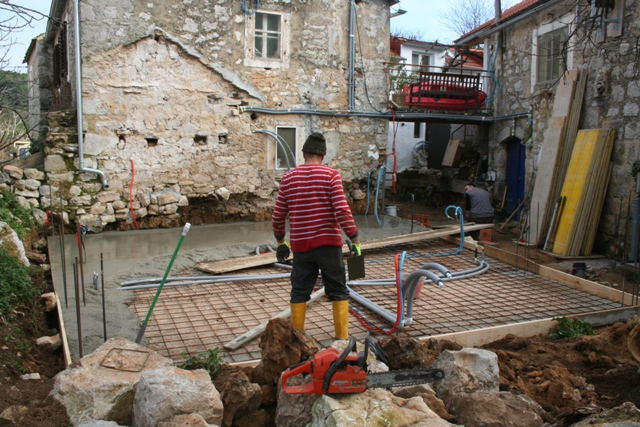
There was no such problem with the small diameter coil and the mid size lengths I have are all straight.
Punching a hole into the Konoba to connect the network to the 28 mm pipes was not too difficult and the builders began pouring the concrete just after 1pm. They finished three hours and many wheelbarrow loads later.
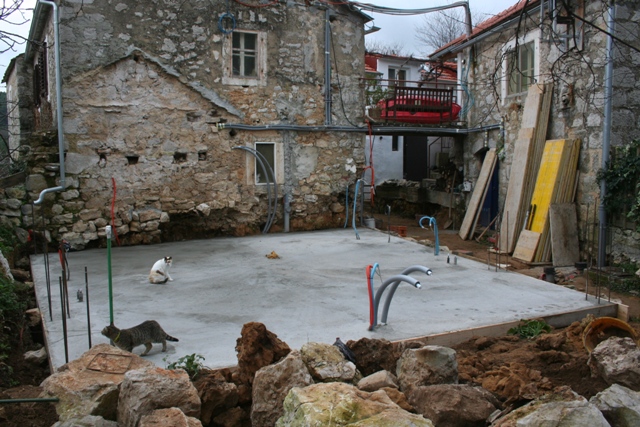
While the concrete was drying I decided I would use an old trick to keep the felines away.
I tied thick cotton thread between all the steel reinforcements, in three cris-crossed strands. The top strand was at head height. The next morning it had almost worked.
There had just been one minor incursion (it was Risha, because he came in with concrete paws). Risha’s paw mark impressions were easily filled and levelled with some mortar.

Orchard fall
With some left over concrete, I started on another project that I have been meaning to get round to. I’ve now got around tuit in more ways than one!

The orchard has a fall of 1.75 meters from the house end, to a near vertical wall at the western end. There are well defined boundaries on both sides of the orchard. The southern boundary is a low breeze block wall which I helped my neighbour construct when I first moved in.
However, this wall stops short of the actual boundary. Because I intend to landscape this area of the orchard I have wanted to extend the concrete footings, then add some more stones to make a wall to hold soil back.
But not having any aggregate has been the limiting factor. I didn’t need a lot and it wasn’t worth trying to order some just for this task.
With some aggregate left over I asked the builder if I could use it. So having used up the left over concrete mix, I’ve also hand mixed ten buckets of concrete and laid the footings.
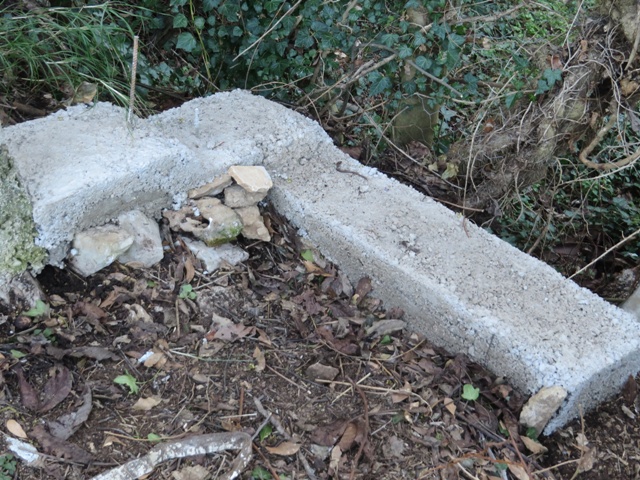
Because the wall at the end is almost vertical (it has a slight, deliberate backslope to hold the earth in place) and is two metres tall, I drove in some metre lengths of rebar so the concrete has something to anchor to. When I was at Volat on Friday, I bought some 40 x 20 cm breeze blocks.
I now need to ask the builders nicely when they are mixing mortar if I can have some, and I will finish the wall.
Ever so slowly, things are coming together…
Keeping one step ahead
Still on the subject of planning, I have been trying all week to keep one step ahead of the builders both in thoughts and deeds.
It’s difficult because I don’t know what they are going to do next and they don’t tell me.
When they came on Wednesday with two pallets of blocks, I realised we were going to start work on the walls. I had in mind to get the windows and door out of the store, so this was the opportunity.
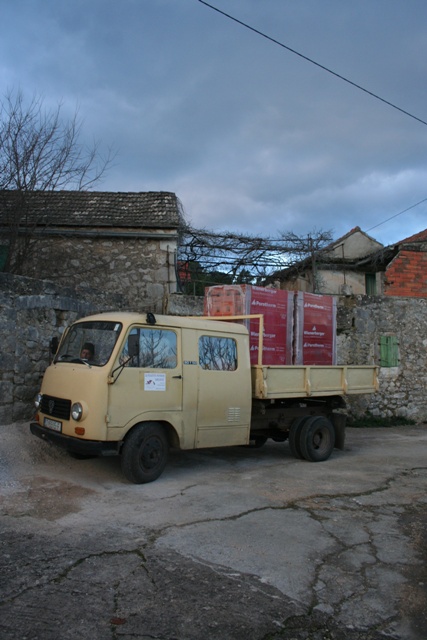
I have pretty much purchased everthing and have had it all in various stores, just waiting for the work to start. So out all the materials came, ready to be installed.
Because the building are askew, the dimensions on the architects drawings and what we have in actual fact are different. Not by much, but I did some quick re-calculations and put the new dimensions into the working drawings folder.
Just in time, because at lunch time Ismail wanted a site meeting to confirm where everything was going.
It didn’t take long to measure and mark on the concrete slab the exact location of the doors and windows. At mid-day, the builders started laying the first of the walling blocks.
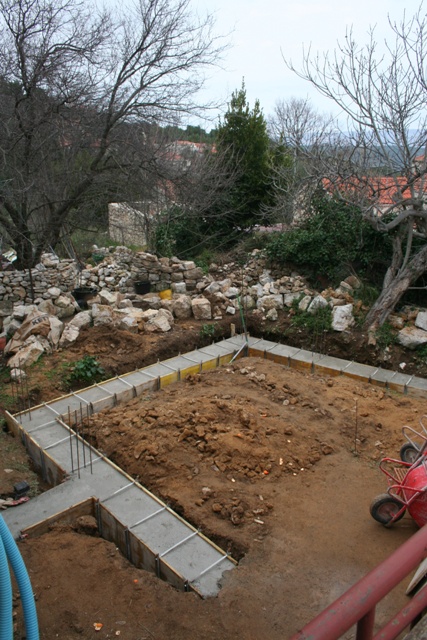
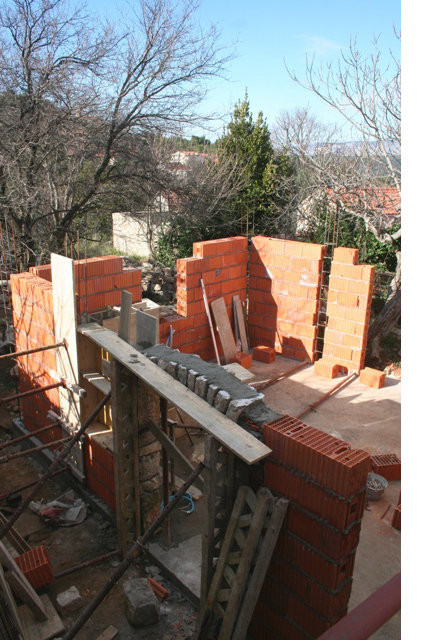
That made me think that by next week we might be doing the ceiling/1st floor, so I had better have everything ready for that part of the project.
So I went back to the master drawings and had some thinking time about what needs to go where. All the utilities will all be buried in the concrete which will become the 1st floor lounge floor.
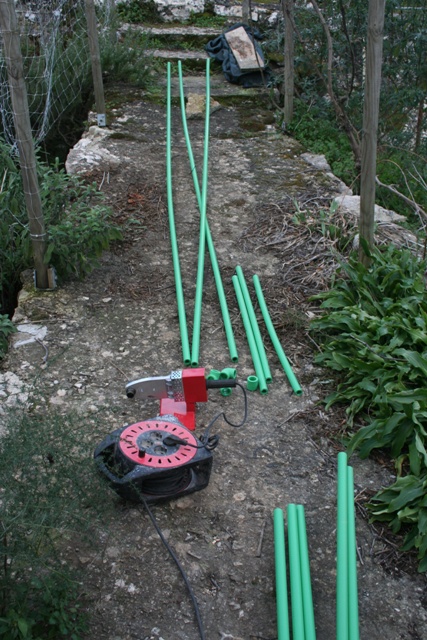
I need water pipes in the concrete ceiling, so out came the pipe welder for the PP-E pipe. Once again, all the needed materials were laid out on the path. Then the components were assembled and the insulation was added to the installation.
Spring has arrived early
Everywhere I look buds are swelling on trees, spring bulbs are in flower and the insects are starting to hatch or wake from their winter hibernation.
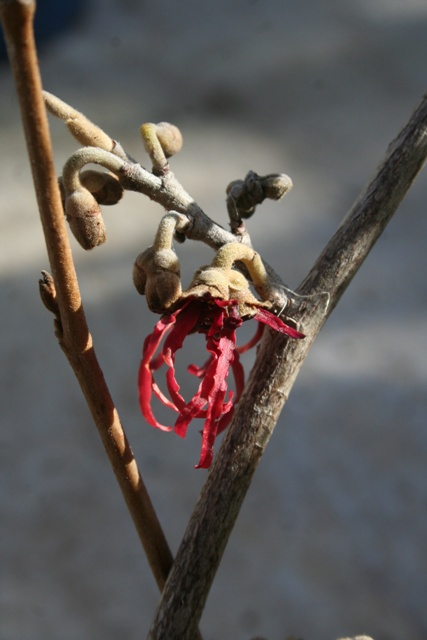
I have not needed a fire on a couple of nights this week because it has been so mild. The effective last date for frost in Dol is the 14th February. We last had a slight radiation frost on the 21st January when the early morning low temperature dropped to +1.3ºC.
So far this winter there have been no nights where the temperature has been below 0ºC.
It is very noticeable that plants like my Canna lilies have remained green all winter. These hail from South Africa and will not stand any frost, dying back to their tuberous rhizomes.

I have both the semi wild Canna Indica and also several Canna cultivars. The range of colours in the cultivars, both the veined leaves and bright, poster paint flowers is stunning.
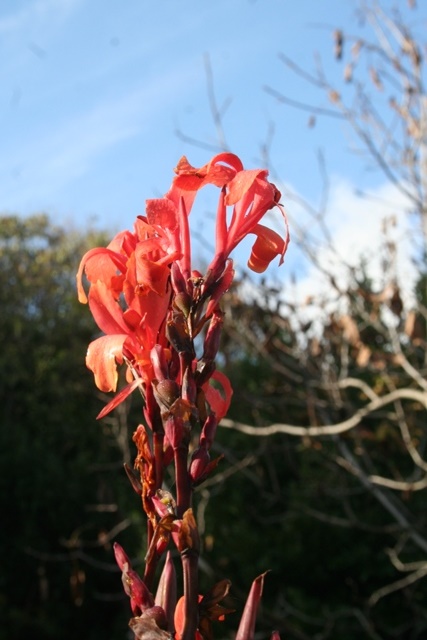
Even if you have to grow them in pots and bring them inside in winter, they are worth the effort.
One of my indicator species for my Springwatch calendar is a bright, shiny fire engine red bug, which appears on the Madonna lilies. They have appeared ten days earlier than last year.

I’ve not been able to find them in my book of insects so I have no idea whether they hibernate or pupate in the spring. They are very colourful at this time of year.

Another early flowerer this is year is my yellow Mimosa, Acacia dealbata.

The shrub I planted is rapidly becoming a small tree, and has its first flowers out, 25 days earlier than 2019.
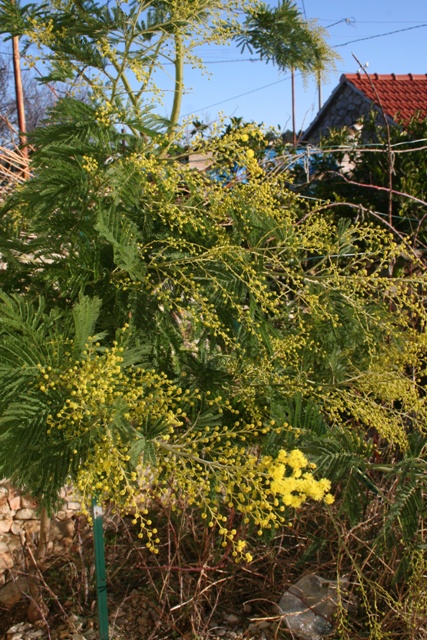
There will always be differences year on year, because of the many variables in rainfall, air and average temperatures and chilling requirements (if any), and sunlight.
Every plant has different triggers that bring it out of it’s dormancy period.
Climate change is squeezing the animals, birds, insects and plants at both the start and finish of the year.
Longer autumns mean that the triggers a plant uses to enter predictive dormancy don’t happen until later in the year. Then when environmental conditions change earlier, they come out of dormancy sooner.
It’s not too much of a problem for plants, unless there is more cold later, but for the birds and mammals which live on, or feed their young on insects which are available at a specific time, if the insects or caterpillars are not there, then it has a knock on effect. NRC

4 Responses
Mary Lynn Woolsey
Risha! Love that cat! I also really enjoy reading about what you’re up to. It seems that you don’t rest much…
Elizabeth
Hi Norman – so glad to read that the building is going well.
On the subject of Mimosa…I saw a beautiful tree in The Victoria Embankment Gardens, just along to the east of The Savoy Hotel. Am in London to go to a Garden History lecture day at The Garden Museum today. It was a lovely sunny afternoon so I walked, wandered really, from KIngs Cross down to my hotel in County Hall. It was a glorious sight in the late afternoon, as the light was receding.
Hope next week goes well for you.
Alan Wheeler
For those that don’t know about Norman’s experience with earthquakes. He was visiting Northern California on Oct. 17th 1989 when the Loma Prieta quake hit. 6.9 to 7.2 on the Richter Scale. This was the largest quake since the 1906 quake that destroyed large parts of San Francisco. The San Francisco-Oakland Bay bridge and part of a major freeway nearby (the Cypress Structure) collapsed. 63 deaths, over 3,000 injuries and 6 billion in property damage.
Lucky for Norman he was in a local nursery when it hit and not riding my BMW which he’d parked outside. No damage to Norman or the BMW.
Hajo
Great work. Now I understand that, when I´m in Stari Grad, never see you in the Kavanas or Bistros!!!